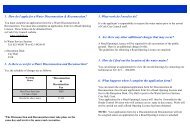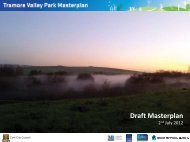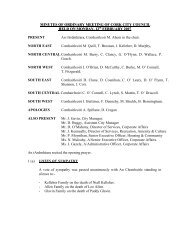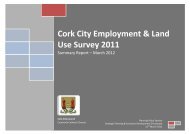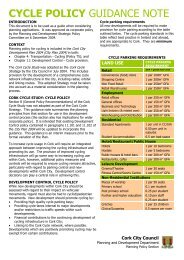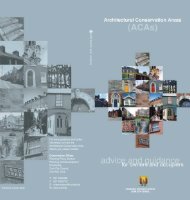Untitled - Cork City Council
Untitled - Cork City Council
Untitled - Cork City Council
Create successful ePaper yourself
Turn your PDF publications into a flip-book with our unique Google optimized e-Paper software.
<strong>Cork</strong> Strategic Retail Study<br />
Table 5.3 Changes In Market Shares For Non-RWH Comparison Goods, 1997-07<br />
1997 2001 2007<br />
<strong>Cork</strong> <strong>City</strong> Centre 70 64 55<br />
Suburban Centres 11 11 11<br />
Mahon Point - - 10<br />
Ring towns 10 12 11<br />
Metropolitan towns 2 1 5<br />
Other 7 12 8<br />
TOTAL 100<br />
5.9 Given the margins of error in a comparison like this it is unwise to make much of small<br />
changes. It is clear however that there has been a continuous decline in the market<br />
share of the <strong>City</strong> Centre – from 70% in 1997 down to 64% in 2001 and 55% in 2007.<br />
This decline is a result of the time taken to implement any substantial retail<br />
development schemes in the <strong>City</strong> Centre and the decision to plan for Mahon Point in<br />
order to meet demand arising at that time. Throughout the period, the share of the<br />
suburban centres has remained broadly constant – they have managed to<br />
accommodate the substantial increases in expenditure without major extensions to<br />
their floorspace. And with no increase in the established suburban centres the slack<br />
has been taken up by Mahon Point, built since 2001, whose present market share is<br />
10%.<br />
5.10 The Ring towns have more or less held their own, partly due to the strong showing by<br />
Mallow in the 2007 survey. There has been a strengthening of the metropolitan towns,<br />
following substantial retail developments in Ballincollig and Midleton. In the period<br />
1997 to 2001 it looks like there was a temporary absorption of pressure by “other”<br />
centres, including those outside the Study Area.<br />
Turnover Tests<br />
5.11 We have investigated the implications of the above results for the sales densities of<br />
groups of centres. These are shown in the chart below.<br />
Figure 5.1 Typical Existing Non-RWH Comparison Goods Sales Densities<br />
Rest of county<br />
Ring towns<br />
Outer met centres<br />
<strong>Cork</strong> suburbs<br />
<strong>Cork</strong> city centre<br />
- 2,000 4,000 6,000 8,000 10,000 12,000<br />
5.12 We have taken account of estimates for imports of spending from outside the Study<br />
Area, based on the results of the shopper survey. Imports to the <strong>City</strong> Centre and<br />
Mahon Point are 14% and 8% of the total turnover (not the residents’ contribution).<br />
Based on location and relative attraction, we estimate comparable figures to be 5% for<br />
Mallow and 4% for Douglas.<br />
Roger Tym & Partners with Simon Clear & Associates<br />
March 2008 33



